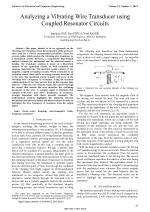| 3/2015 - 12 |
Analyzing a Vibrating Wire Transducer using Coupled Resonator CircuitsPOP, S. |
| Extra paper information in |
| Click to see author's profile in |
| Download PDF |
Author keywords
coils, damping, electromagnetic fields, frequency, transducer
References keywords
power(11), vibrating(9), transfer(6), systems(6), coupled(5), technique(4), electronics(4), circuits(4)
Blue keywords are present in both the references section and the paper title.
About this article
Date of Publication: 2015-08-31
Volume 15, Issue 3, Year 2015, On page(s): 87 - 92
ISSN: 1582-7445, e-ISSN: 1844-7600
Digital Object Identifier: 10.4316/AECE.2015.03012
Web of Science Accession Number: 000360171500012
SCOPUS ID: 84940737028
Abstract
This paper intends to be an approach on the vibrating wire transducer from the perspective of the necessary rules used for a correct measurement procedure. There are several studies which analyze the vibrating wire transducer as a mechanical system. However, a comparative time-domain analysis between the mechanical and the electrical model is lacking. The transducer analysis is based on a theoretical analysis of the equivalent circuit, on both excitation and response time intervals. The electrical model consists of two magnetic coupled resonating circuits. When connected to an excitation source, there will be an energy transfer from the coil to the wire. The maximum energy transfer will occur at the vibrating wire's frequency of resonance. Using the transient regime analysis, it has been proven that, in the response time interval - when the wire vibrates freely, the current through the circuit that models the wire describes the oscillating movement of the wire. A complex signal is obtained, that contains both coil's and wire's frequencies of resonance, strongly dependent with theirs parasitic elements. The mathematical analysis highlights the similarity between mechanical and electrical model and the procedures in order to determine the wire frequency of resonance from the output signal. |
| References | | | Cited By |
Web of Science® Times Cited: 2 [View]
View record in Web of Science® [View]
View Related Records® [View]
Updated today
SCOPUS® Times Cited: 2
View record in SCOPUS® [Free preview]
View citations in SCOPUS® [Free preview]
[1] Statistical Frequency Estimation Techniques for Vibrating Wire Sensor Signals, Diwakar, G, Roy, Lakshi Prosad, TENCON 2019 - 2019 IEEE Region 10 Conference (TENCON), ISBN 978-1-7281-1895-6, 2019.
Digital Object Identifier: 10.1109/TENCON.2019.8929676 [CrossRef]
[2] Digital Processing Method used to Improve the Frequency Measurement Accuracy for Vibrating-Wire Transducers, Pop, S., Bande, V., 2019 IEEE 25th International Symposium for Design and Technology in Electronic Packaging (SIITME), ISBN 978-1-7281-3330-0, 2019.
Digital Object Identifier: 10.1109/SIITME47687.2019.8990888 [CrossRef]
Disclaimer: All information displayed above was retrieved by using remote connections to respective databases. For the best user experience, we update all data by using background processes, and use caches in order to reduce the load on the servers we retrieve the information from. As we have no control on the availability of the database servers and sometimes the Internet connectivity may be affected, we do not guarantee the information is correct or complete. For the most accurate data, please always consult the database sites directly. Some external links require authentication or an institutional subscription.
Web of Science® is a registered trademark of Clarivate Analytics, Scopus® is a registered trademark of Elsevier B.V., other product names, company names, brand names, trademarks and logos are the property of their respective owners.
Faculty of Electrical Engineering and Computer Science
Stefan cel Mare University of Suceava, Romania
All rights reserved: Advances in Electrical and Computer Engineering is a registered trademark of the Stefan cel Mare University of Suceava. No part of this publication may be reproduced, stored in a retrieval system, photocopied, recorded or archived, without the written permission from the Editor. When authors submit their papers for publication, they agree that the copyright for their article be transferred to the Faculty of Electrical Engineering and Computer Science, Stefan cel Mare University of Suceava, Romania, if and only if the articles are accepted for publication. The copyright covers the exclusive rights to reproduce and distribute the article, including reprints and translations.
Permission for other use: The copyright owner's consent does not extend to copying for general distribution, for promotion, for creating new works, or for resale. Specific written permission must be obtained from the Editor for such copying. Direct linking to files hosted on this website is strictly prohibited.
Disclaimer: Whilst every effort is made by the publishers and editorial board to see that no inaccurate or misleading data, opinions or statements appear in this journal, they wish to make it clear that all information and opinions formulated in the articles, as well as linguistic accuracy, are the sole responsibility of the author.



